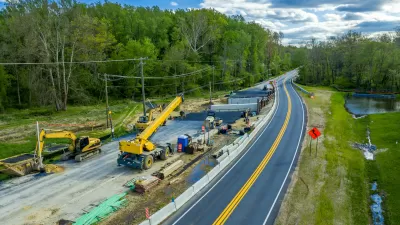The well-documented concept has yet to catch on in state departments of transportation, but acknowledging it could dramatically transform U.S. transportation policy.

Despite frequent and repeated evidence that adding roadway capacity attracts more drivers, Jake Blumgart examines why the concept of induced demand remains a 'hard sell' for many policymakers and transportation professionals.
"Induced demand has been theorized for almost 100 years, formally studied beginning in the 1960s, and quantitatively measured in the 1990s and the early 21st century. This basic concept is key to understanding congestion relief, which is arguably the central policy goal of American transportation planning." Yet the somewhat counterintuitive idea remains "one of the least understood concepts in transportation policy," Blumgart writes, with the consequences apparent in transportation planning and projects across the country.
Blumgart describes how the phenomenon works—essentially, "If the speed of traffic in a given network increases, that prompts people to drive more"— and why it's hard to understand—a combination of intuition and decades of road expansion presented as the solution to traffic, including by transportation engineers. "An entire industry has been built up around endless road expansion and advocacy organizations like the American Society of Civil Engineers are skilled lobbyists for continuing current practices."
Meanwhile, politicians are afraid to reject road expansion proposals and their immediate effects on congestion in favor of long-term planning and unpopular, but effective, alternatives like congestion pricing.
In a future article in the same Governing series, Blumgart will describe how induced demand could change policy in state DOTs.
FULL STORY: Why the Concept of Induced Demand Is a Hard Sell

Study: Maui’s Plan to Convert Vacation Rentals to Long-Term Housing Could Cause Nearly $1 Billion Economic Loss
The plan would reduce visitor accommodation by 25,% resulting in 1,900 jobs lost.

North Texas Transit Leaders Tout Benefits of TOD for Growing Region
At a summit focused on transit-oriented development, policymakers discussed how North Texas’ expanded light rail system can serve as a tool for economic growth.

Using Old Oil and Gas Wells for Green Energy Storage
Penn State researchers have found that repurposing abandoned oil and gas wells for geothermal-assisted compressed-air energy storage can boost efficiency, reduce environmental risks, and support clean energy and job transitions.

Santa Barbara Could Build Housing on County Land
County supervisors moved forward a proposal to build workforce housing on two county-owned parcels.

San Mateo Formally Opposes Freeway Project
The city council will send a letter to Caltrans urging the agency to reconsider a plan to expand the 101 through the city of San Mateo.

A Bronx Community Fights to Have its Voice Heard
After organizing and giving input for decades, the community around the Kingsbridge Armory might actually see it redeveloped — and they want to continue to have a say in how it goes.
Urban Design for Planners 1: Software Tools
This six-course series explores essential urban design concepts using open source software and equips planners with the tools they need to participate fully in the urban design process.
Planning for Universal Design
Learn the tools for implementing Universal Design in planning regulations.
Ascent Environmental
Borough of Carlisle
Institute for Housing and Urban Development Studies (IHS)
City of Grandview
Harvard GSD Executive Education
Toledo-Lucas County Plan Commissions
Salt Lake City
NYU Wagner Graduate School of Public Service





























